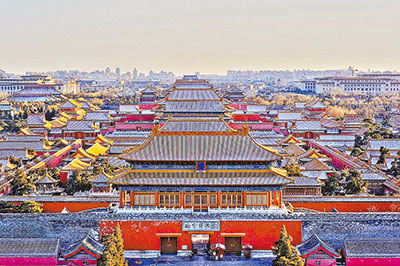
Debra Li debra_lidan@163.com BUILT symmetrically along Beijing’s axis, the Forbidden City, once the imperial palace during the Ming (1368-1644) and Qing (1644-1911) dynasties, is now a UNESCO world culture heritage site that was visited by 16 million in 2016. To kindle interest in traditional Chinese culture, Jin Hongkui, a Beijing-based archaeologist, gave a lecture on the architecture of this majestic palace to local audiences at Artron Art Center in Nanshan District on Sunday morning. “Walking along the alleys in the Forbidden City and meditating about what had happened there is very romantic,” the scholar said. Sharing lesser-known facts and stories, he guided audiences on a virtual tour. Occupying 106 hectares with a floor space of more than 160,000 sqm, the sprawling complex was first built during the reign of Ming Emperor Yongle (reign 1402-1424). Claiming the throne after a bloody struggle, the emperor in the then capital Nanjing had long hoped to return to his dominion in the north. Afraid of resistance against moving the capital, he had one minister raise the proposal of building a new place for his “short stay” on visits to Beijing. Preparations for construction, such as logging and brick making, started in many provinces around the country in 1406. The project was officially launched in 1415, when the economy was good and the national treasury was able to afford it. But a fire burned down the three main halls not long after construction was completed, and the project was not finished until the reign of Yongle’s grandson. The main structures of the Forbidden City remained untouched but later emperors, such as Qing Emperor Qianlong (reign 1735-1796), made modifications and additions. The Meridian Gate (Wu Men), the southern entrance of the Forbidden City, is the largest and the main gate to this magnificent ancient architectural complex. Ministers would begin to wait by 5 a.m. outside the gate for the emperor to summon them in to report and receive orders. Contrary to common belief that people were beheaded in front of the gate, this was the place where ceremonies were held before wars were launched and when imperial decrees were issued. However, Jin noted that a dozen ministers were actually beaten to death outside the gate during the reign of Ming Emperor Jiajing (reign 1521-1567), because beating as a punishment for ministers was a common practice at the time. The Hall of Supreme Harmony (Taihe Dian), the first of the three main halls in the outer court, has the longest terrace — eight meters high with three layers. The hall including the terrace is 35 meters high. The stone lion heads around the terrace serve as decorations as well as drainage systems, creating a spectacular sight during heavy rains. The design of the roof is also attractive, with 10 mythical animals at each of its corners. Not just decorative, the mini sculptures also serve to stabilize the eaves. Burned down four times, the current hall is the fifth version built during the reign of Qing Emperor Kangxi (reign 1661-1722). Unlike many other buildings that were made of cedar, this one was made of pine which was easy to procure in the north. Despite its supreme status, the building was used less than 10 times each year, for such important ceremonies as royal coronations, weddings of the emperor or celebrations on New Year’s Day, winter solstice and the emperor’s birthday. The Palace of Heavenly Purity (Qianqing Gong) is a more mundane place where the emperor had his family dinners on special occasions. There is a plate inscribed with “正大光明” (“just and honorable”) handwritten by Emperor Kangxi himself hanging in the palace, behind which a secret envelop was tucked away containing the name of the person next in line for the throne, only to be unveiled after the death of the current emperor. This practice started with Emperor Yongzheng (reign 1722-1735), who had seen too much bloodshed in the fight for the throne. The Palace of Earthly Tranquility (Kunning Gong) was built for the chief consort of the emperor. During Qing times, the palace was remodeled into a Manchu-style house, which was dubbed a “pocket house.” The house has its main door to the east rather than in the center; wooden panel doors replaced lattice doors; windows open from the bottom (swinging out on hinges fastened at the top) and are propped up by sticks. Inside the palace, along the north, the west and the south walls are linked heated brick platforms (kang). The palace was the Shamanist sacrificial hall and the imperial bridal chamber. It retains the original decor today. It was the bridal chamber for the Kangxi, Tongzhi (reign 1861-1875), Guangxu (reign 1875-1908) and the abdicated Xuantong (reign 1909-1911) emperors. The couples only spent their first two days of marriage in this palace. Then they moved to live in the Palace of Heavenly Purity or the Hall of Mental Cultivation (Yangxin Dian). A cozy study in the latter is well-known and kept as it was, where Emperor Qianlong kept the calligraphies of Wang Xizhi, Wang Xianzhi and Wang Xun and named it “Three Precious Rooms” (Sanxi Tang). Unlike his predecessors, Emperor Qianlong decided he did not want to die on his throne and became the first emperor to retire. He built himself a garden and fitted a Chinese opera stage into his dwelling, along with many other new architectural inventions. Despite his taste for novel things, the emperor didn’t opt for the luxury of glass windows, which were not widely used until the times of Empress Dowager Cixi (reign 1861-1908). None of them had access to the convenience of a Western toilet and had to have their bodily waste transported out of the Forbidden City twice a week. | 
